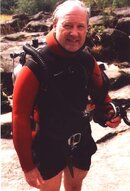Halocline, you forgot to see the question mark on the op-ed title. The title was a question, not a statement. I put that in purposely to allow discussion of this type of system, and possibly a determination. If you'll read through the whole thread, you'll see that I have conceded that this is not the "most redundant" system available. However, it does stimulate thinking, and that was my goal.
Now, concerning the long hose, I have one, and it does markedly improve performance on the regulator I put it on, which is the original Calypso by U.S. Divers Company (from the early 1960s, with the exhalation diaphragm in the main diaphragm). But it also has a limitation--the original orifice of the tank valve.
It's like a river with a dam, and a reservoir. That reservoir can be opened, and water flows. If it is opened hugely, the water will flow until it matches the creek that is feeding it upstream, and then it will flow no faster. But if there are two creeks upstream feeding that reservoir, then it will flow twice as fast once the reservoir is depleted.
Now, getting back to my long hose, I put it on the Calypso on purpose, so that if I ever dived with guys who were DIR, I would have a regulator that met their specs, but would also cause some conversation. I have a pressure gauge on it, along with a splitter and a safe second, which is a second generation Calypso with the original neck strap. I have an LP inflator hose on it too.
I just recently bought a Dacor Quantum regulator, which I consider the grandchild of the orginal Calypso regulator, as it incorporates the same design features with a better, higher volume exhaust. I had it as the safe second on the A.I.R. I setup pictured here.
Concerning my tests, I have what I have, and it did show a difference.

I am not a commercial facility, nor a dive shop. I simply am using what I have available. You can question the test methods, which is fine. But try to show some test results of your own. It appears that you have both the Pilot and the A.I.R. I, so run a few tests with better equipment, preferably with charted IP reductions and correlated to both a 2 L/breath and a 4 L/breath respiratory volume. I am curious about the results.
Thanks for the information on the metal poppet. I did not know such a creature existed. I'll make an inquiry with a LDS I know and see whether one is available.
SeaRat






